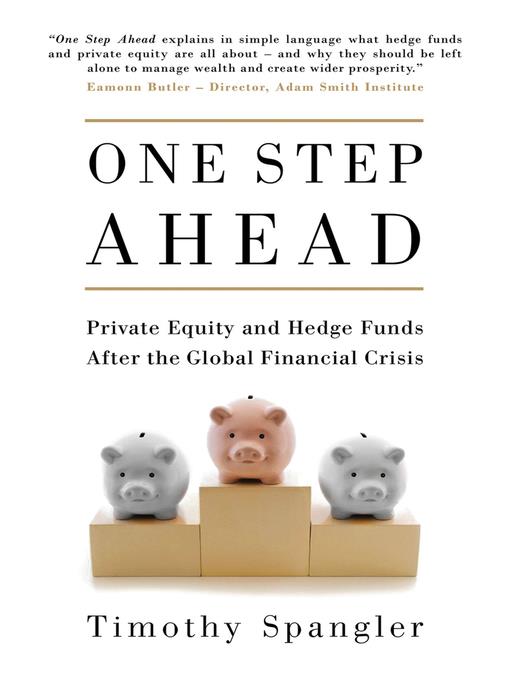
One Step Ahead
Private Equity and Hedge Funds After the Global Financial Crisis
کتاب های مرتبط
- اطلاعات
- نقد و بررسی
- دیدگاه کاربران
نقد و بررسی

December 2, 2013
In his first book, UCLA Law professor Spangler offers an informative overview of alternative investments while taking a critical look at the industry. Dense but readable, the book will demystify unregulated investments and provide a helpful examination of fund structures and a detailed breakdown of their operations. Spangler reviews the role of private equity and hedge funds in the recent financial crisis but does not blame them for the economic crash. Despite considerable mention of such high-profile alternative investment managers as Steve Cohen, Henry Kravis, and George Soros, he also recognizes their contributions to society. Though he acknowledges that the SEC has its "shortcomings," he maintains that fraud is not exclusive to this industry. Readers hoping for an indictment of alternative investments will be disappointed. While the book's appeal may be limited to readers interested in investment management or global finance, that target market is sure to find this a comprehensive guide to a portion of the industry often neglected by other business titles.

October 1, 2013
Forbes.com "Law of the Market" blogger Spangler (The Law of Private Investment Funds, 2012, etc.) looks at hedge and private equity funds, which he believes will continue to have a function going forward. The author brings his legal expertise to bear on the many questions surrounding the structures of hedge and equity funds. Aware of ever-louder criticism and divided opinions, Spangler seeks to counter the "many misconceptions and biases" in the mainstream media. He believes that there is a function for financial organizations committed to pursuing higher returns for their investors by taking on higher risks. Hedge funds and private equity funds fill that slot. The author also looks at the darker side of the issue. Hedge funds, he shows, are now shored up by deposits from public pension plans, which chase the higher returns meant for their investors. Spangler reports that "many observers inexperienced with alternative funds are often quite surprised" to learn that many states are entrusting their retirement funds to these financial highfliers. Of course, other investors include those with enough income and assets to "fend for themselves," and regulators have turned their attention in that direction as well--e.g., the investors caught in Bernie Madoff's pyramid scam. Spangler discusses how hedge and equity funds are created and the processes by which their managers are empowered and protected from liability, while ensuring that their fees are paid. He also examines the tax advantages of the structures, especially the benefits of moving assets offshore. According to the author, President Barack Obama's proposals to change these types of tax breaks can be compared "to Hitler's 1939 invasion of Poland." Ultimately, whether such funds really outperform others remains unclear. An informative examination of a niche market facing significant change.
COPYRIGHT(2013) Kirkus Reviews, ALL RIGHTS RESERVED.

September 15, 2013
Private equity and hedge funds have become an important part of a sound investment strategy, but recent high-profile frauds and the global financial crisis have exposed the risk they pose to the uninformed investor. In this detailed guide to how these alternative investment funds work, commentator and blogger Spangler (partner & chair, investment funds, Kaye Scholer LLP; Law of the Market blog) balances dense financial information on the creation and regulation of this sector of the market with wit and anecdotes from popular culture. The first five chapters outline how these funds work, who manages them and why, and how most of their capital comes from pensions and university endowments. After explaining the basics of fund creation and management, Spangler dedicates the following four chapters to a current outlook on these investments in the financial climate of today and the complicated relationship among the firms that manage the funds, politicians, and government regulators. The book ends with a look at how these funds work within a global network. VERDICT This detailed outline of how private equity and hedge funds function will appeal to an audience already familiar with the basics of financial investment. Recommended.--John Rodzvilla, Emerson Coll., Boston
Copyright 2013 Library Journal, LLC Used with permission.

September 15, 2013
Private equity and hedge funds are an often misunderstood and maligned segment of the investment world, sparsely regulated and often relegated to the dark corners of Wall Street, but together they represent more than $3 trillion in assets. Hedge funds specialize in complex investment strategies, often involving high risk; they are increasingly sought after by pension managers, university endowments, charities, and banks to boost yields and play catch-up on prior losses. Private-equity funds purchase distressed and undervalued companies for reorganization; Mitt Romney's ties to private-equity fund Bain Capital put the industry into the spotlight during the private-equity bashing of the 2012 presidential campaign. Spangler examines the state of the industry in the aftermath of the 2008 financial crisis, which caused more than 1,000 funds to shutter. He considers the consequences of financial-reform legislation and the Bernie Madoff scandal that exposed these funds to higher scrutiny. Spangler dispels myths about how these funds operate and comes down as an advocate for them without sugarcoating the risks involved. Spangler is a writer, commentator, lawyer, and academic who divides his time between Southern California and the UK.(Reprinted with permission of Booklist, copyright 2013, American Library Association.)

























دیدگاه کاربران